Software Development Methodologies: Platform Research Project Analysis
VerifiedAdded on 2021/02/22
|8
|2100
|422
Report
AI Summary
This report presents a comprehensive analysis of various software development methodologies, including Agile, Waterfall, and Extreme Programming. The report begins with an introduction to software development methodologies and their significance in structuring, planning, and controlling the creation of information systems. Task 1 delves into the features, benefits, and suitable applications of each methodology, identifying sectors where they are most effective. Task 2 focuses on creating a proposal and procurement report, specifically recommending Agile methodology. The report outlines the reasons for selecting Agile, the procurement process, and the benefits of its implementation, such as cost-effectiveness, shorter lead times, and improved team efficiency. The report concludes with a recommendation to employ the Agile methodology due to its flexibility, client integration, and potential for improved product quality and user satisfaction.
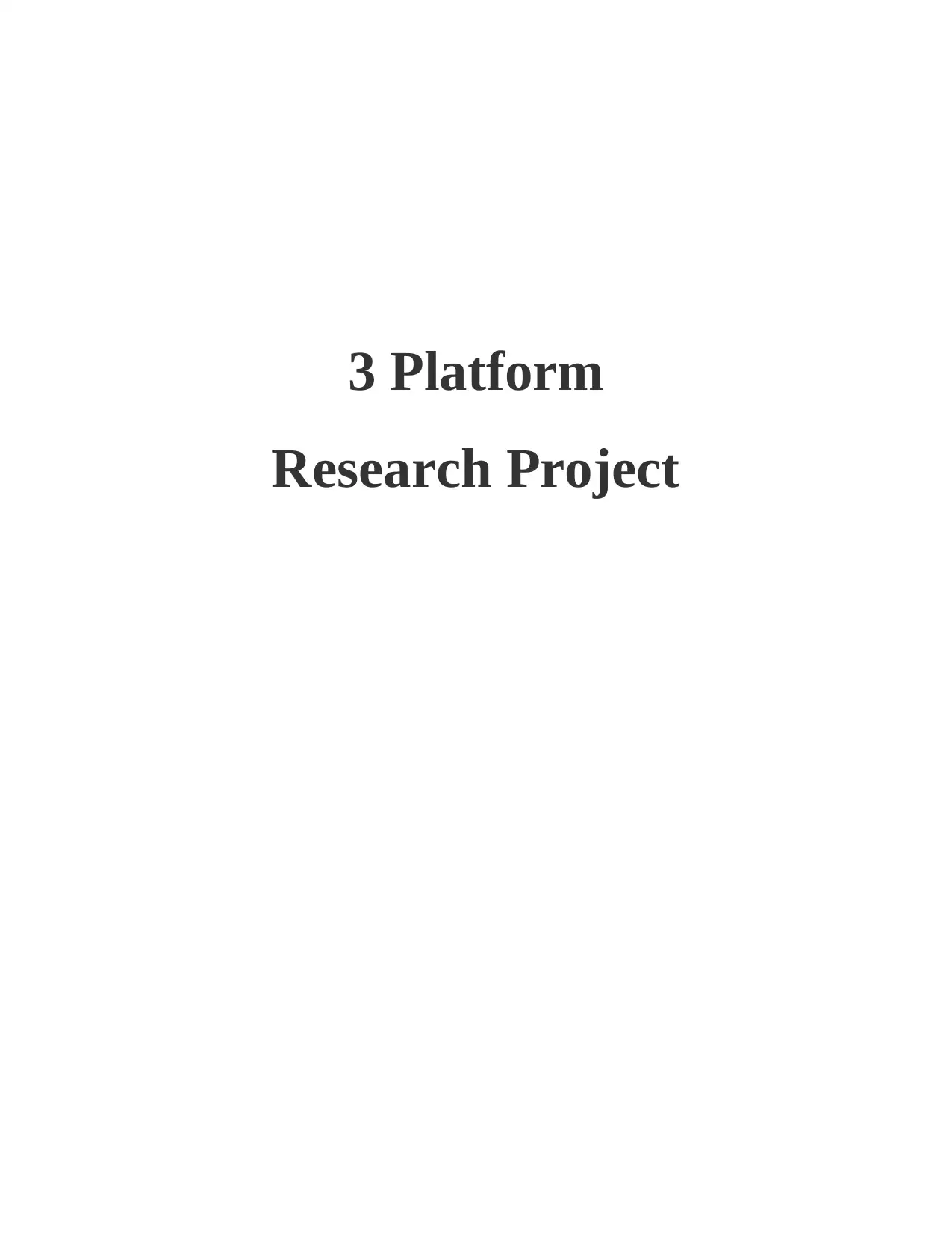
3 Platform
Research Project
Research Project
Paraphrase This Document
Need a fresh take? Get an instant paraphrase of this document with our AI Paraphraser
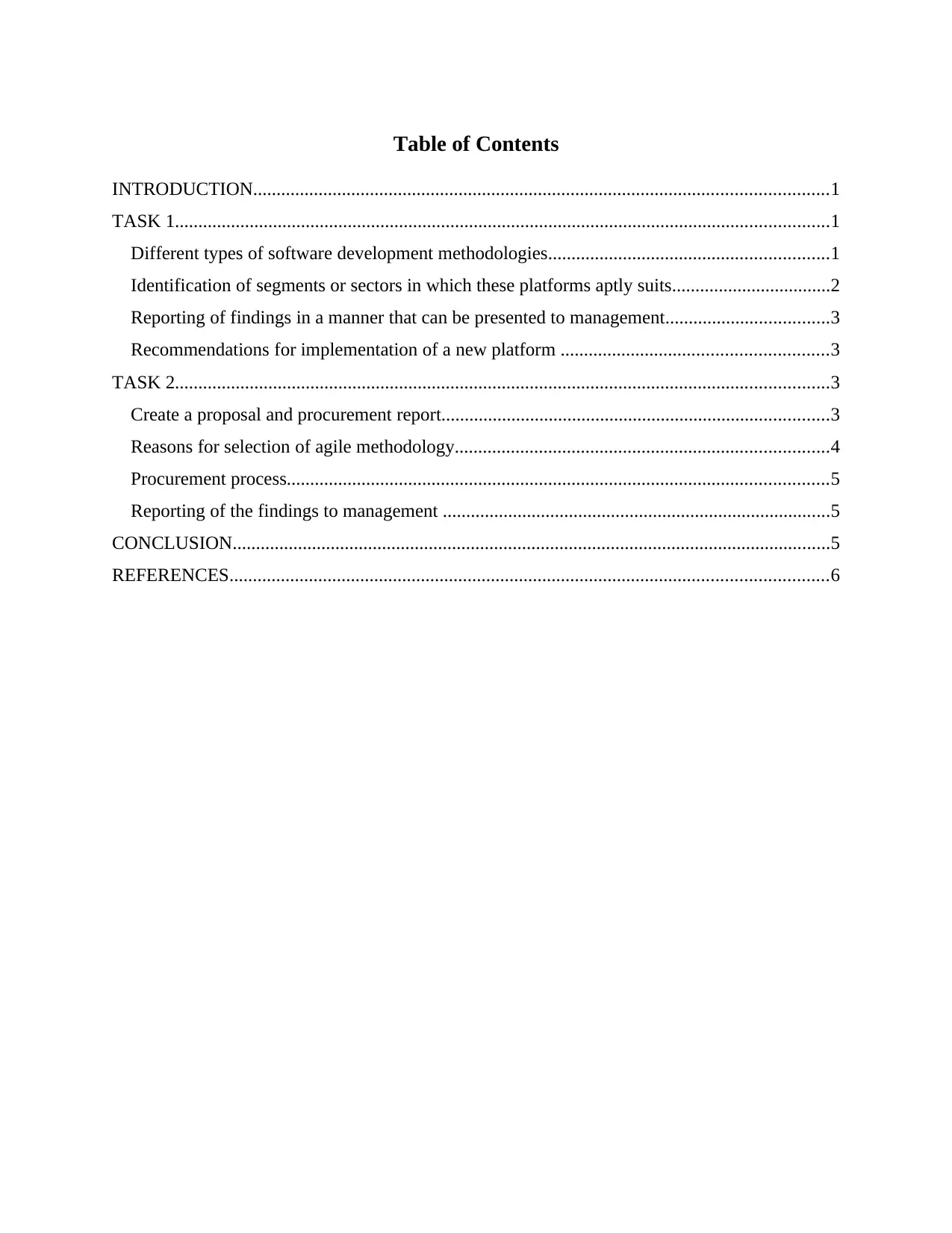
Table of Contents
INTRODUCTION...........................................................................................................................1
TASK 1............................................................................................................................................1
Different types of software development methodologies............................................................1
Identification of segments or sectors in which these platforms aptly suits..................................2
Reporting of findings in a manner that can be presented to management...................................3
Recommendations for implementation of a new platform .........................................................3
TASK 2............................................................................................................................................3
Create a proposal and procurement report...................................................................................3
Reasons for selection of agile methodology................................................................................4
Procurement process....................................................................................................................5
Reporting of the findings to management ...................................................................................5
CONCLUSION................................................................................................................................5
REFERENCES................................................................................................................................6
INTRODUCTION...........................................................................................................................1
TASK 1............................................................................................................................................1
Different types of software development methodologies............................................................1
Identification of segments or sectors in which these platforms aptly suits..................................2
Reporting of findings in a manner that can be presented to management...................................3
Recommendations for implementation of a new platform .........................................................3
TASK 2............................................................................................................................................3
Create a proposal and procurement report...................................................................................3
Reasons for selection of agile methodology................................................................................4
Procurement process....................................................................................................................5
Reporting of the findings to management ...................................................................................5
CONCLUSION................................................................................................................................5
REFERENCES................................................................................................................................6
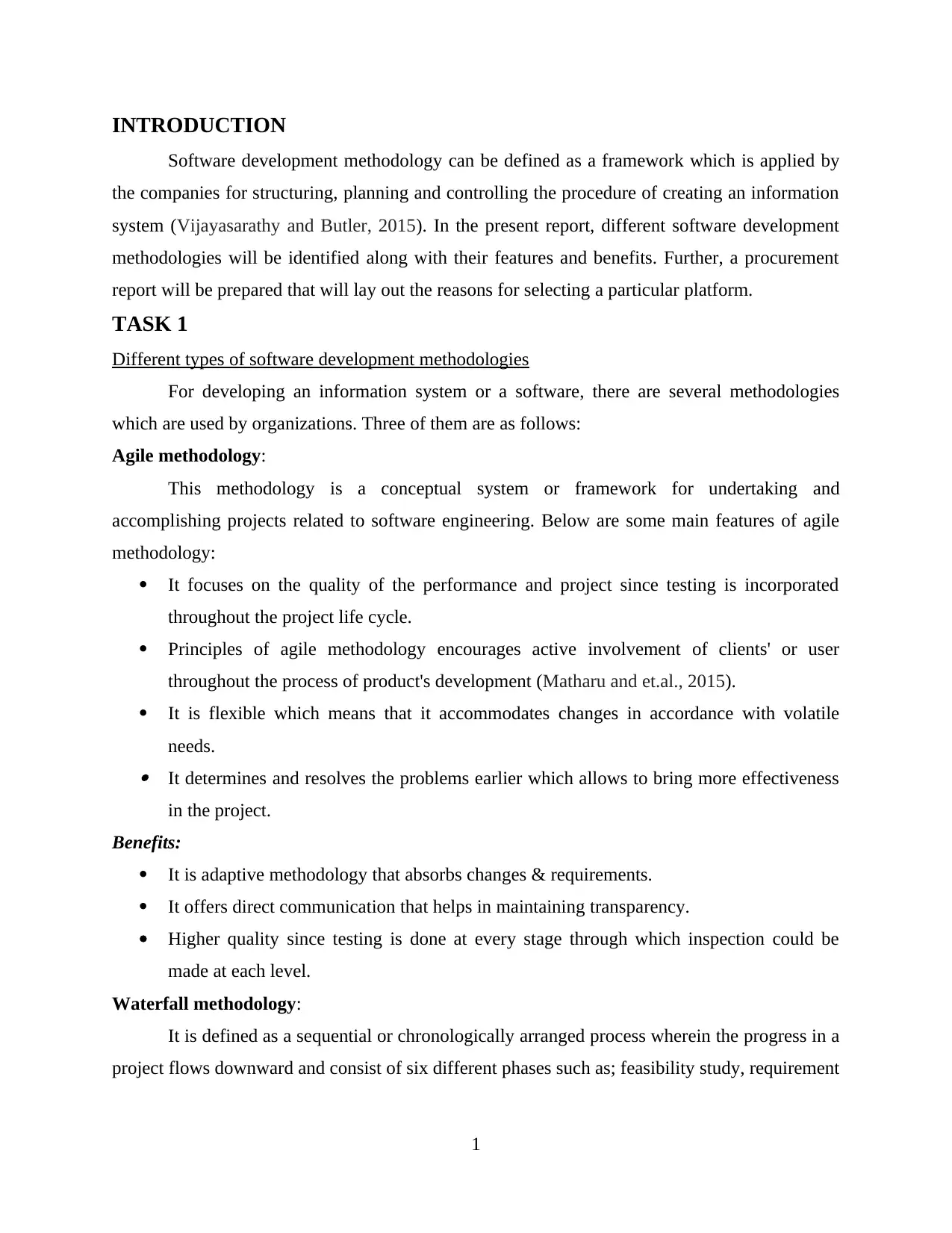
INTRODUCTION
Software development methodology can be defined as a framework which is applied by
the companies for structuring, planning and controlling the procedure of creating an information
system (Vijayasarathy and Butler, 2015). In the present report, different software development
methodologies will be identified along with their features and benefits. Further, a procurement
report will be prepared that will lay out the reasons for selecting a particular platform.
TASK 1
Different types of software development methodologies
For developing an information system or a software, there are several methodologies
which are used by organizations. Three of them are as follows:
Agile methodology:
This methodology is a conceptual system or framework for undertaking and
accomplishing projects related to software engineering. Below are some main features of agile
methodology:
It focuses on the quality of the performance and project since testing is incorporated
throughout the project life cycle.
Principles of agile methodology encourages active involvement of clients' or user
throughout the process of product's development (Matharu and et.al., 2015).
It is flexible which means that it accommodates changes in accordance with volatile
needs. It determines and resolves the problems earlier which allows to bring more effectiveness
in the project.
Benefits:
It is adaptive methodology that absorbs changes & requirements.
It offers direct communication that helps in maintaining transparency.
Higher quality since testing is done at every stage through which inspection could be
made at each level.
Waterfall methodology:
It is defined as a sequential or chronologically arranged process wherein the progress in a
project flows downward and consist of six different phases such as; feasibility study, requirement
1
Software development methodology can be defined as a framework which is applied by
the companies for structuring, planning and controlling the procedure of creating an information
system (Vijayasarathy and Butler, 2015). In the present report, different software development
methodologies will be identified along with their features and benefits. Further, a procurement
report will be prepared that will lay out the reasons for selecting a particular platform.
TASK 1
Different types of software development methodologies
For developing an information system or a software, there are several methodologies
which are used by organizations. Three of them are as follows:
Agile methodology:
This methodology is a conceptual system or framework for undertaking and
accomplishing projects related to software engineering. Below are some main features of agile
methodology:
It focuses on the quality of the performance and project since testing is incorporated
throughout the project life cycle.
Principles of agile methodology encourages active involvement of clients' or user
throughout the process of product's development (Matharu and et.al., 2015).
It is flexible which means that it accommodates changes in accordance with volatile
needs. It determines and resolves the problems earlier which allows to bring more effectiveness
in the project.
Benefits:
It is adaptive methodology that absorbs changes & requirements.
It offers direct communication that helps in maintaining transparency.
Higher quality since testing is done at every stage through which inspection could be
made at each level.
Waterfall methodology:
It is defined as a sequential or chronologically arranged process wherein the progress in a
project flows downward and consist of six different phases such as; feasibility study, requirement
1
⊘ This is a preview!⊘
Do you want full access?
Subscribe today to unlock all pages.

Trusted by 1+ million students worldwide
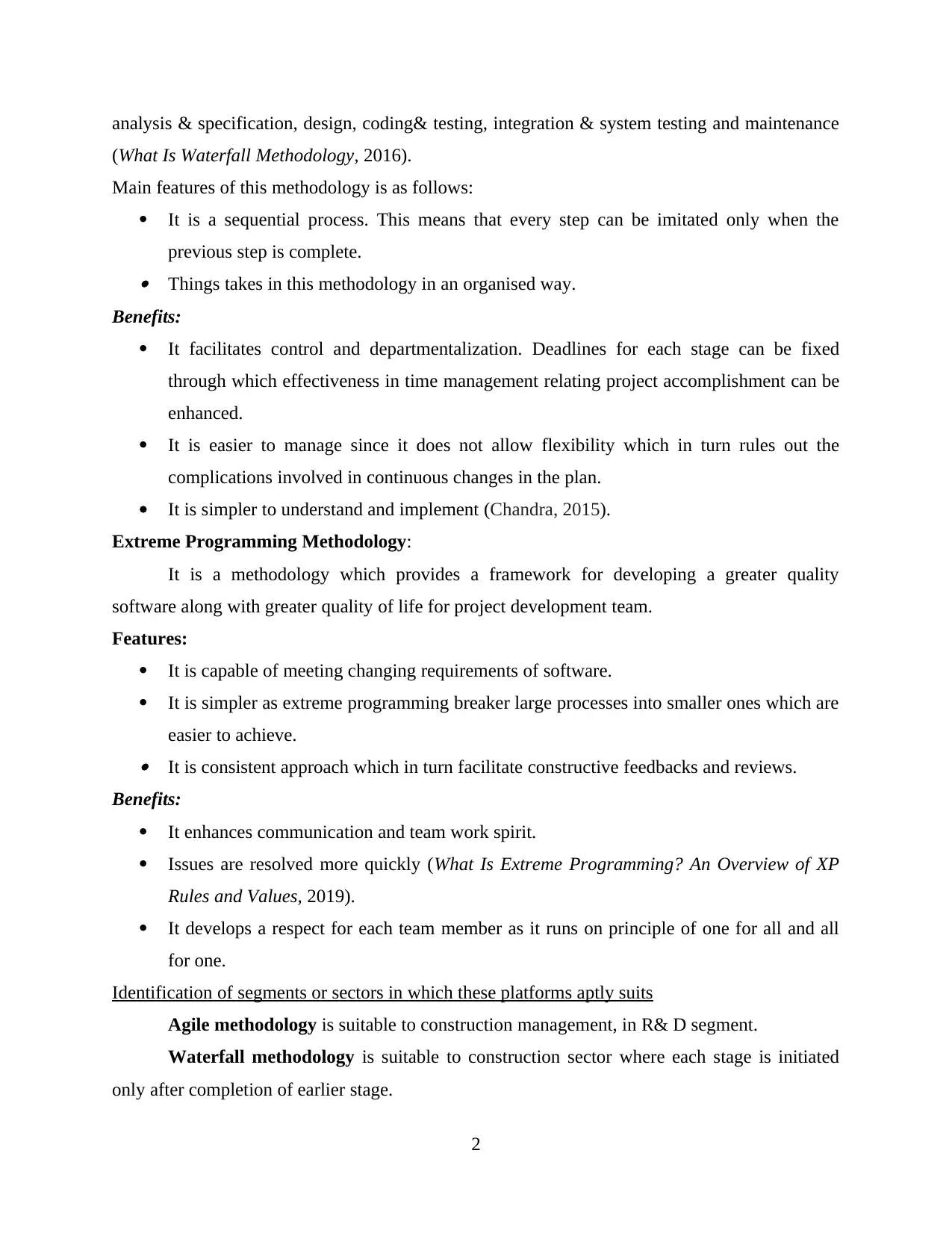
analysis & specification, design, coding& testing, integration & system testing and maintenance
(What Is Waterfall Methodology, 2016).
Main features of this methodology is as follows:
It is a sequential process. This means that every step can be imitated only when the
previous step is complete. Things takes in this methodology in an organised way.
Benefits:
It facilitates control and departmentalization. Deadlines for each stage can be fixed
through which effectiveness in time management relating project accomplishment can be
enhanced.
It is easier to manage since it does not allow flexibility which in turn rules out the
complications involved in continuous changes in the plan.
It is simpler to understand and implement (Chandra, 2015).
Extreme Programming Methodology:
It is a methodology which provides a framework for developing a greater quality
software along with greater quality of life for project development team.
Features:
It is capable of meeting changing requirements of software.
It is simpler as extreme programming breaker large processes into smaller ones which are
easier to achieve. It is consistent approach which in turn facilitate constructive feedbacks and reviews.
Benefits:
It enhances communication and team work spirit.
Issues are resolved more quickly (What Is Extreme Programming? An Overview of XP
Rules and Values, 2019).
It develops a respect for each team member as it runs on principle of one for all and all
for one.
Identification of segments or sectors in which these platforms aptly suits
Agile methodology is suitable to construction management, in R& D segment.
Waterfall methodology is suitable to construction sector where each stage is initiated
only after completion of earlier stage.
2
(What Is Waterfall Methodology, 2016).
Main features of this methodology is as follows:
It is a sequential process. This means that every step can be imitated only when the
previous step is complete. Things takes in this methodology in an organised way.
Benefits:
It facilitates control and departmentalization. Deadlines for each stage can be fixed
through which effectiveness in time management relating project accomplishment can be
enhanced.
It is easier to manage since it does not allow flexibility which in turn rules out the
complications involved in continuous changes in the plan.
It is simpler to understand and implement (Chandra, 2015).
Extreme Programming Methodology:
It is a methodology which provides a framework for developing a greater quality
software along with greater quality of life for project development team.
Features:
It is capable of meeting changing requirements of software.
It is simpler as extreme programming breaker large processes into smaller ones which are
easier to achieve. It is consistent approach which in turn facilitate constructive feedbacks and reviews.
Benefits:
It enhances communication and team work spirit.
Issues are resolved more quickly (What Is Extreme Programming? An Overview of XP
Rules and Values, 2019).
It develops a respect for each team member as it runs on principle of one for all and all
for one.
Identification of segments or sectors in which these platforms aptly suits
Agile methodology is suitable to construction management, in R& D segment.
Waterfall methodology is suitable to construction sector where each stage is initiated
only after completion of earlier stage.
2
Paraphrase This Document
Need a fresh take? Get an instant paraphrase of this document with our AI Paraphraser
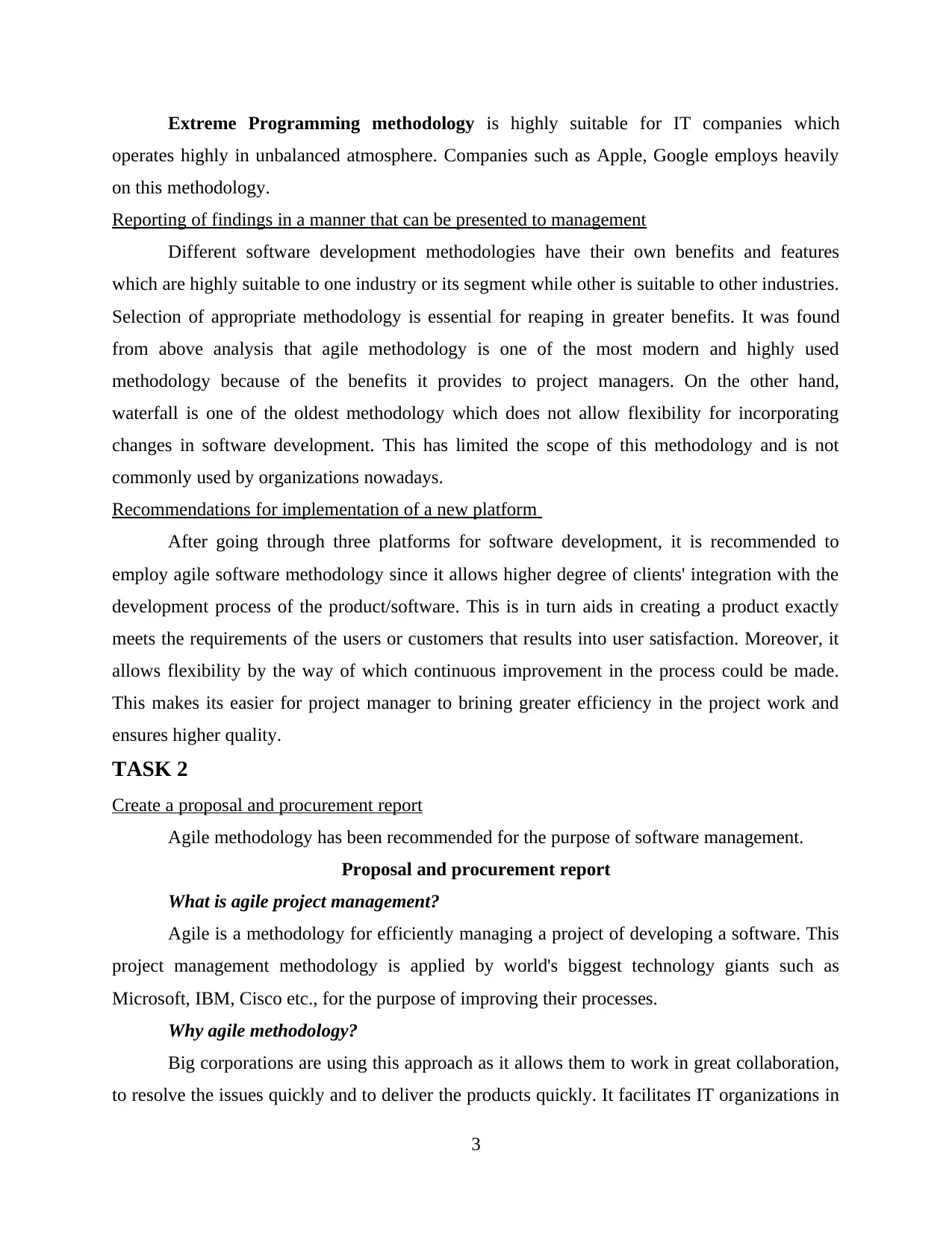
Extreme Programming methodology is highly suitable for IT companies which
operates highly in unbalanced atmosphere. Companies such as Apple, Google employs heavily
on this methodology.
Reporting of findings in a manner that can be presented to management
Different software development methodologies have their own benefits and features
which are highly suitable to one industry or its segment while other is suitable to other industries.
Selection of appropriate methodology is essential for reaping in greater benefits. It was found
from above analysis that agile methodology is one of the most modern and highly used
methodology because of the benefits it provides to project managers. On the other hand,
waterfall is one of the oldest methodology which does not allow flexibility for incorporating
changes in software development. This has limited the scope of this methodology and is not
commonly used by organizations nowadays.
Recommendations for implementation of a new platform
After going through three platforms for software development, it is recommended to
employ agile software methodology since it allows higher degree of clients' integration with the
development process of the product/software. This is in turn aids in creating a product exactly
meets the requirements of the users or customers that results into user satisfaction. Moreover, it
allows flexibility by the way of which continuous improvement in the process could be made.
This makes its easier for project manager to brining greater efficiency in the project work and
ensures higher quality.
TASK 2
Create a proposal and procurement report
Agile methodology has been recommended for the purpose of software management.
Proposal and procurement report
What is agile project management?
Agile is a methodology for efficiently managing a project of developing a software. This
project management methodology is applied by world's biggest technology giants such as
Microsoft, IBM, Cisco etc., for the purpose of improving their processes.
Why agile methodology?
Big corporations are using this approach as it allows them to work in great collaboration,
to resolve the issues quickly and to deliver the products quickly. It facilitates IT organizations in
3
operates highly in unbalanced atmosphere. Companies such as Apple, Google employs heavily
on this methodology.
Reporting of findings in a manner that can be presented to management
Different software development methodologies have their own benefits and features
which are highly suitable to one industry or its segment while other is suitable to other industries.
Selection of appropriate methodology is essential for reaping in greater benefits. It was found
from above analysis that agile methodology is one of the most modern and highly used
methodology because of the benefits it provides to project managers. On the other hand,
waterfall is one of the oldest methodology which does not allow flexibility for incorporating
changes in software development. This has limited the scope of this methodology and is not
commonly used by organizations nowadays.
Recommendations for implementation of a new platform
After going through three platforms for software development, it is recommended to
employ agile software methodology since it allows higher degree of clients' integration with the
development process of the product/software. This is in turn aids in creating a product exactly
meets the requirements of the users or customers that results into user satisfaction. Moreover, it
allows flexibility by the way of which continuous improvement in the process could be made.
This makes its easier for project manager to brining greater efficiency in the project work and
ensures higher quality.
TASK 2
Create a proposal and procurement report
Agile methodology has been recommended for the purpose of software management.
Proposal and procurement report
What is agile project management?
Agile is a methodology for efficiently managing a project of developing a software. This
project management methodology is applied by world's biggest technology giants such as
Microsoft, IBM, Cisco etc., for the purpose of improving their processes.
Why agile methodology?
Big corporations are using this approach as it allows them to work in great collaboration,
to resolve the issues quickly and to deliver the products quickly. It facilitates IT organizations in
3
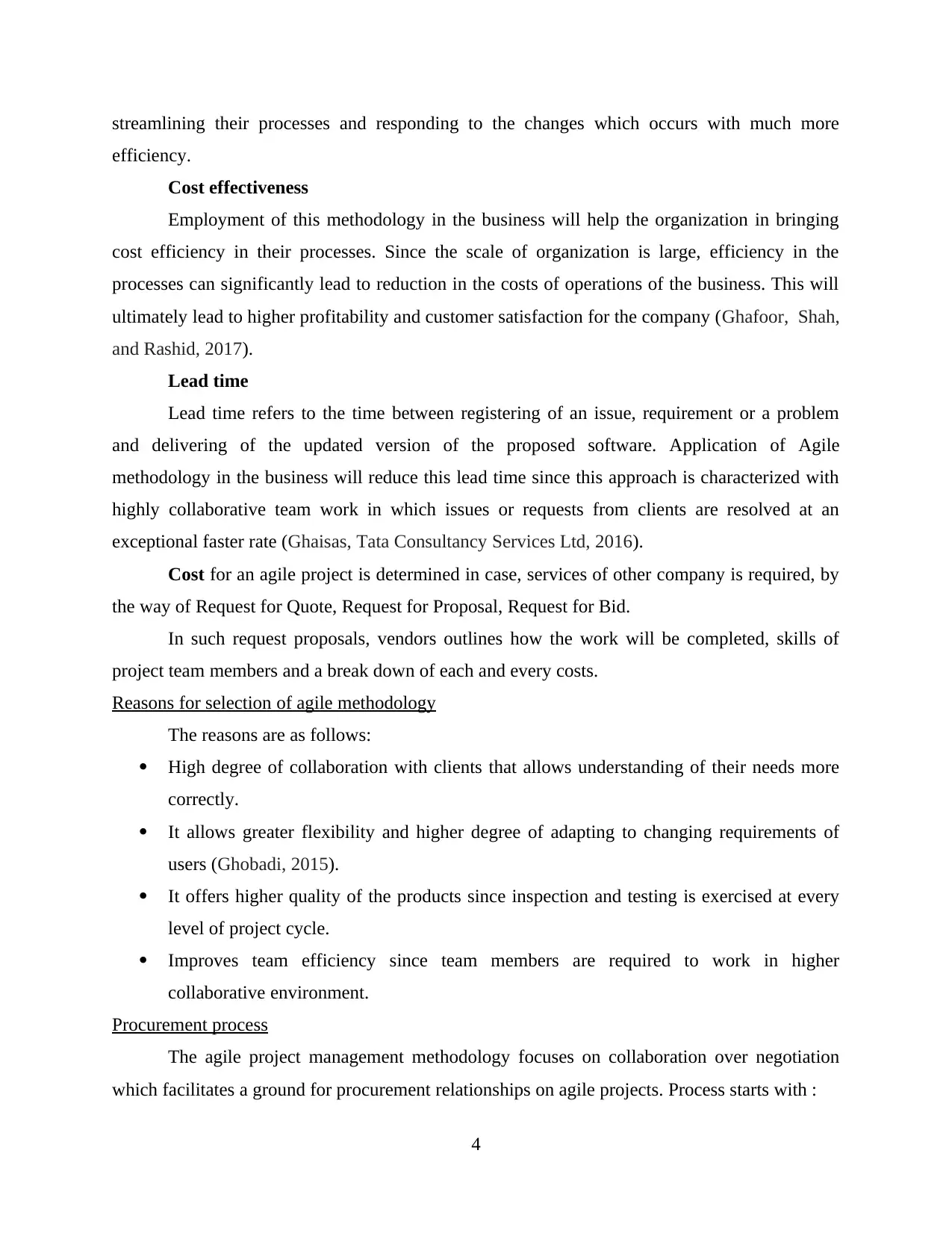
streamlining their processes and responding to the changes which occurs with much more
efficiency.
Cost effectiveness
Employment of this methodology in the business will help the organization in bringing
cost efficiency in their processes. Since the scale of organization is large, efficiency in the
processes can significantly lead to reduction in the costs of operations of the business. This will
ultimately lead to higher profitability and customer satisfaction for the company (Ghafoor, Shah,
and Rashid, 2017).
Lead time
Lead time refers to the time between registering of an issue, requirement or a problem
and delivering of the updated version of the proposed software. Application of Agile
methodology in the business will reduce this lead time since this approach is characterized with
highly collaborative team work in which issues or requests from clients are resolved at an
exceptional faster rate (Ghaisas, Tata Consultancy Services Ltd, 2016).
Cost for an agile project is determined in case, services of other company is required, by
the way of Request for Quote, Request for Proposal, Request for Bid.
In such request proposals, vendors outlines how the work will be completed, skills of
project team members and a break down of each and every costs.
Reasons for selection of agile methodology
The reasons are as follows:
High degree of collaboration with clients that allows understanding of their needs more
correctly.
It allows greater flexibility and higher degree of adapting to changing requirements of
users (Ghobadi, 2015).
It offers higher quality of the products since inspection and testing is exercised at every
level of project cycle.
Improves team efficiency since team members are required to work in higher
collaborative environment.
Procurement process
The agile project management methodology focuses on collaboration over negotiation
which facilitates a ground for procurement relationships on agile projects. Process starts with :
4
efficiency.
Cost effectiveness
Employment of this methodology in the business will help the organization in bringing
cost efficiency in their processes. Since the scale of organization is large, efficiency in the
processes can significantly lead to reduction in the costs of operations of the business. This will
ultimately lead to higher profitability and customer satisfaction for the company (Ghafoor, Shah,
and Rashid, 2017).
Lead time
Lead time refers to the time between registering of an issue, requirement or a problem
and delivering of the updated version of the proposed software. Application of Agile
methodology in the business will reduce this lead time since this approach is characterized with
highly collaborative team work in which issues or requests from clients are resolved at an
exceptional faster rate (Ghaisas, Tata Consultancy Services Ltd, 2016).
Cost for an agile project is determined in case, services of other company is required, by
the way of Request for Quote, Request for Proposal, Request for Bid.
In such request proposals, vendors outlines how the work will be completed, skills of
project team members and a break down of each and every costs.
Reasons for selection of agile methodology
The reasons are as follows:
High degree of collaboration with clients that allows understanding of their needs more
correctly.
It allows greater flexibility and higher degree of adapting to changing requirements of
users (Ghobadi, 2015).
It offers higher quality of the products since inspection and testing is exercised at every
level of project cycle.
Improves team efficiency since team members are required to work in higher
collaborative environment.
Procurement process
The agile project management methodology focuses on collaboration over negotiation
which facilitates a ground for procurement relationships on agile projects. Process starts with :
4
⊘ This is a preview!⊘
Do you want full access?
Subscribe today to unlock all pages.

Trusted by 1+ million students worldwide
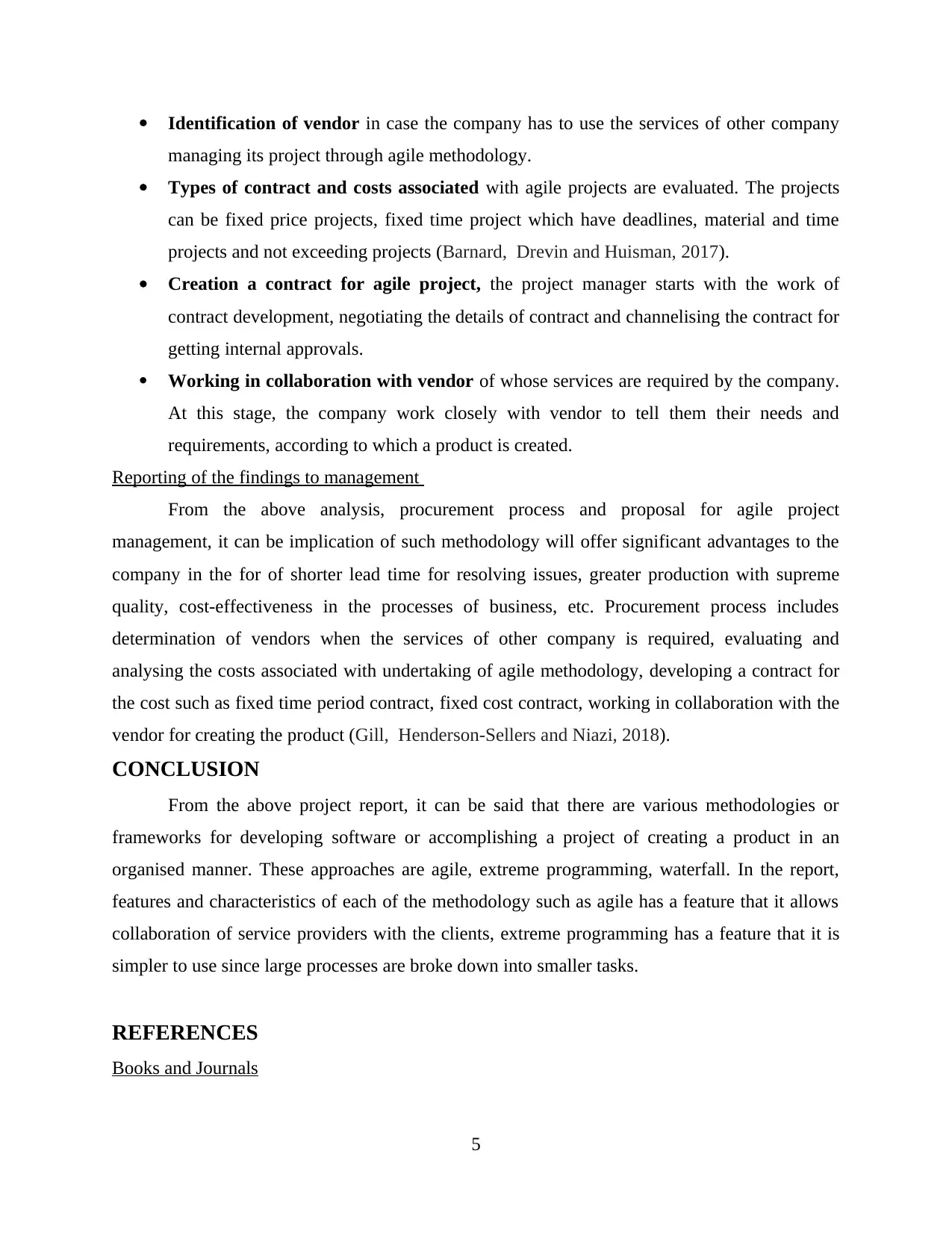
Identification of vendor in case the company has to use the services of other company
managing its project through agile methodology.
Types of contract and costs associated with agile projects are evaluated. The projects
can be fixed price projects, fixed time project which have deadlines, material and time
projects and not exceeding projects (Barnard, Drevin and Huisman, 2017).
Creation a contract for agile project, the project manager starts with the work of
contract development, negotiating the details of contract and channelising the contract for
getting internal approvals.
Working in collaboration with vendor of whose services are required by the company.
At this stage, the company work closely with vendor to tell them their needs and
requirements, according to which a product is created.
Reporting of the findings to management
From the above analysis, procurement process and proposal for agile project
management, it can be implication of such methodology will offer significant advantages to the
company in the for of shorter lead time for resolving issues, greater production with supreme
quality, cost-effectiveness in the processes of business, etc. Procurement process includes
determination of vendors when the services of other company is required, evaluating and
analysing the costs associated with undertaking of agile methodology, developing a contract for
the cost such as fixed time period contract, fixed cost contract, working in collaboration with the
vendor for creating the product (Gill, Henderson-Sellers and Niazi, 2018).
CONCLUSION
From the above project report, it can be said that there are various methodologies or
frameworks for developing software or accomplishing a project of creating a product in an
organised manner. These approaches are agile, extreme programming, waterfall. In the report,
features and characteristics of each of the methodology such as agile has a feature that it allows
collaboration of service providers with the clients, extreme programming has a feature that it is
simpler to use since large processes are broke down into smaller tasks.
REFERENCES
Books and Journals
5
managing its project through agile methodology.
Types of contract and costs associated with agile projects are evaluated. The projects
can be fixed price projects, fixed time project which have deadlines, material and time
projects and not exceeding projects (Barnard, Drevin and Huisman, 2017).
Creation a contract for agile project, the project manager starts with the work of
contract development, negotiating the details of contract and channelising the contract for
getting internal approvals.
Working in collaboration with vendor of whose services are required by the company.
At this stage, the company work closely with vendor to tell them their needs and
requirements, according to which a product is created.
Reporting of the findings to management
From the above analysis, procurement process and proposal for agile project
management, it can be implication of such methodology will offer significant advantages to the
company in the for of shorter lead time for resolving issues, greater production with supreme
quality, cost-effectiveness in the processes of business, etc. Procurement process includes
determination of vendors when the services of other company is required, evaluating and
analysing the costs associated with undertaking of agile methodology, developing a contract for
the cost such as fixed time period contract, fixed cost contract, working in collaboration with the
vendor for creating the product (Gill, Henderson-Sellers and Niazi, 2018).
CONCLUSION
From the above project report, it can be said that there are various methodologies or
frameworks for developing software or accomplishing a project of creating a product in an
organised manner. These approaches are agile, extreme programming, waterfall. In the report,
features and characteristics of each of the methodology such as agile has a feature that it allows
collaboration of service providers with the clients, extreme programming has a feature that it is
simpler to use since large processes are broke down into smaller tasks.
REFERENCES
Books and Journals
5
Paraphrase This Document
Need a fresh take? Get an instant paraphrase of this document with our AI Paraphraser
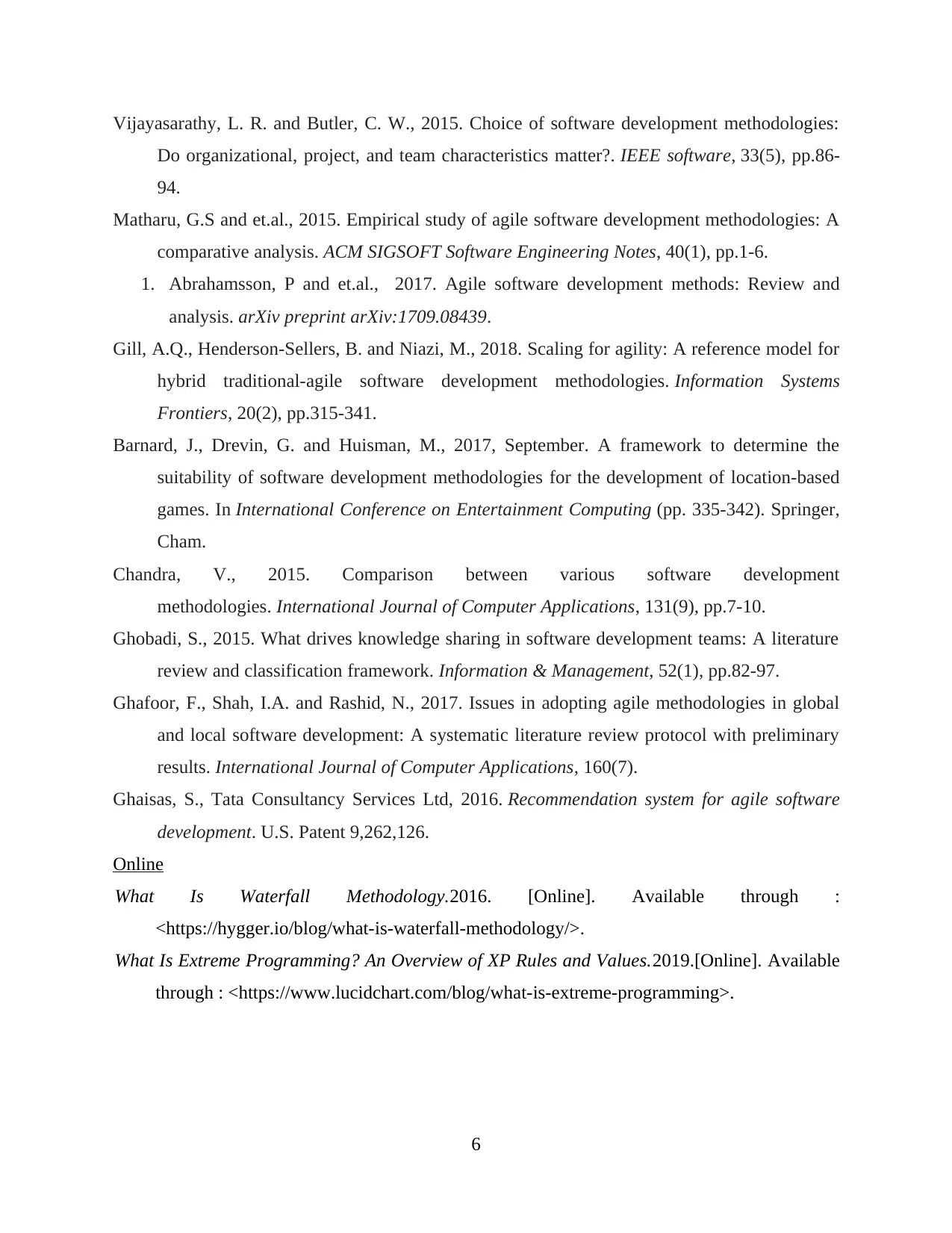
Vijayasarathy, L. R. and Butler, C. W., 2015. Choice of software development methodologies:
Do organizational, project, and team characteristics matter?. IEEE software, 33(5), pp.86-
94.
Matharu, G.S and et.al., 2015. Empirical study of agile software development methodologies: A
comparative analysis. ACM SIGSOFT Software Engineering Notes, 40(1), pp.1-6.
1. Abrahamsson, P and et.al., 2017. Agile software development methods: Review and
analysis. arXiv preprint arXiv:1709.08439.
Gill, A.Q., Henderson-Sellers, B. and Niazi, M., 2018. Scaling for agility: A reference model for
hybrid traditional-agile software development methodologies. Information Systems
Frontiers, 20(2), pp.315-341.
Barnard, J., Drevin, G. and Huisman, M., 2017, September. A framework to determine the
suitability of software development methodologies for the development of location-based
games. In International Conference on Entertainment Computing (pp. 335-342). Springer,
Cham.
Chandra, V., 2015. Comparison between various software development
methodologies. International Journal of Computer Applications, 131(9), pp.7-10.
Ghobadi, S., 2015. What drives knowledge sharing in software development teams: A literature
review and classification framework. Information & Management, 52(1), pp.82-97.
Ghafoor, F., Shah, I.A. and Rashid, N., 2017. Issues in adopting agile methodologies in global
and local software development: A systematic literature review protocol with preliminary
results. International Journal of Computer Applications, 160(7).
Ghaisas, S., Tata Consultancy Services Ltd, 2016. Recommendation system for agile software
development. U.S. Patent 9,262,126.
Online
What Is Waterfall Methodology.2016. [Online]. Available through :
<https://hygger.io/blog/what-is-waterfall-methodology/>.
What Is Extreme Programming? An Overview of XP Rules and Values.2019.[Online]. Available
through : <https://www.lucidchart.com/blog/what-is-extreme-programming>.
6
Do organizational, project, and team characteristics matter?. IEEE software, 33(5), pp.86-
94.
Matharu, G.S and et.al., 2015. Empirical study of agile software development methodologies: A
comparative analysis. ACM SIGSOFT Software Engineering Notes, 40(1), pp.1-6.
1. Abrahamsson, P and et.al., 2017. Agile software development methods: Review and
analysis. arXiv preprint arXiv:1709.08439.
Gill, A.Q., Henderson-Sellers, B. and Niazi, M., 2018. Scaling for agility: A reference model for
hybrid traditional-agile software development methodologies. Information Systems
Frontiers, 20(2), pp.315-341.
Barnard, J., Drevin, G. and Huisman, M., 2017, September. A framework to determine the
suitability of software development methodologies for the development of location-based
games. In International Conference on Entertainment Computing (pp. 335-342). Springer,
Cham.
Chandra, V., 2015. Comparison between various software development
methodologies. International Journal of Computer Applications, 131(9), pp.7-10.
Ghobadi, S., 2015. What drives knowledge sharing in software development teams: A literature
review and classification framework. Information & Management, 52(1), pp.82-97.
Ghafoor, F., Shah, I.A. and Rashid, N., 2017. Issues in adopting agile methodologies in global
and local software development: A systematic literature review protocol with preliminary
results. International Journal of Computer Applications, 160(7).
Ghaisas, S., Tata Consultancy Services Ltd, 2016. Recommendation system for agile software
development. U.S. Patent 9,262,126.
Online
What Is Waterfall Methodology.2016. [Online]. Available through :
<https://hygger.io/blog/what-is-waterfall-methodology/>.
What Is Extreme Programming? An Overview of XP Rules and Values.2019.[Online]. Available
through : <https://www.lucidchart.com/blog/what-is-extreme-programming>.
6
1 out of 8
Related Documents
Your All-in-One AI-Powered Toolkit for Academic Success.
+13062052269
info@desklib.com
Available 24*7 on WhatsApp / Email
![[object Object]](/_next/static/media/star-bottom.7253800d.svg)
Unlock your academic potential
Copyright © 2020–2025 A2Z Services. All Rights Reserved. Developed and managed by ZUCOL.




